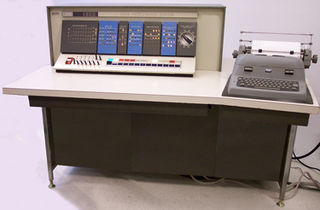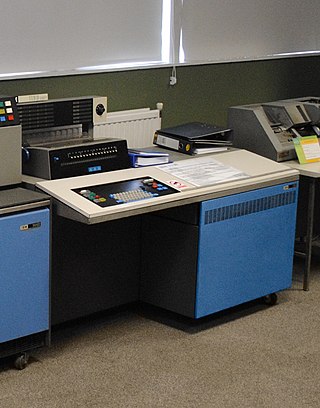Related Research Articles
A disk operating system (DOS) is a computer operating system that resides on and can use a disk storage device, such as a floppy disk, hard disk drive, or optical disc. A disk operating system provides a file system for organizing, reading, and writing files on the storage disk, and a means for loading and running programs stored on that disk. Strictly, this definition does not include any other functionality, so it does not apply to more complex OSes, such as Microsoft Windows, and is more appropriately used only for older generations of operating systems.

The IBM System/360 (S/360) is a family of mainframe computer systems that was announced by IBM on April 7, 1964, and delivered between 1965 and 1978. It was the first family of computers designed to cover both commercial and scientific applications and a complete range of applications from small to large. The design distinguished between architecture and implementation, allowing IBM to release a suite of compatible designs at different prices. All but the only partially compatible Model 44 and the most expensive systems use microcode to implement the instruction set, featuring 8-bit byte addressing and binary, decimal and hexadecimal floating-point calculations.
Control Data Corporation (CDC) was a mainframe and supercomputer firm. CDC was one of the nine major United States computer companies through most of the 1960s; the others were IBM, Burroughs Corporation, DEC, NCR, General Electric, Honeywell, RCA, and UNIVAC. CDC was well-known and highly regarded throughout the industry at the time. For most of the 1960s, Seymour Cray worked at CDC and developed a series of machines that were the fastest computers in the world by far, until Cray left the company to found Cray Research (CRI) in the 1970s. After several years of losses in the early 1980s, in 1988 CDC started to leave the computer manufacturing business and sell the related parts of the company, a process that was completed in 1992 with the creation of Control Data Systems, Inc. The remaining businesses of CDC currently operate as Ceridian.
RT-11 is a discontinued small, low-end, single-user real-time operating system for the full line of Digital Equipment Corporation PDP-11 16-bit computers. RT-11 was first implemented in 1970. It was widely used for real-time computing systems, process control, and data acquisition across all PDP-11s. It was also used for low-cost general-use computing.

The IBM 1620 was announced by IBM on October 21, 1959, and marketed as an inexpensive scientific computer. After a total production of about two thousand machines, it was withdrawn on November 19, 1970. Modified versions of the 1620 were used as the CPU of the IBM 1710 and IBM 1720 Industrial Process Control Systems.

UNIVAC was a line of electronic digital stored-program computers starting with the products of the Eckert–Mauchly Computer Corporation. Later the name was applied to a division of the Remington Rand company and successor organizations.
OS/8 is the primary operating system used on the Digital Equipment Corporation's PDP-8 minicomputer.

The IBM 1130 Computing System, introduced in 1965, was IBM's least expensive computer at that time. A binary 16-bit machine, it was marketed to price-sensitive, computing-intensive technical markets, like education and engineering, succeeding the decimal IBM 1620 in that market segment. Typical installations included a 1 megabyte disk drive that stored the operating system, compilers and object programs, with program source generated and maintained on punched cards. Fortran was the most common programming language used, but several others, including APL, were available.
Prime Computer, Inc. was a Natick, Massachusetts-based producer of minicomputers from 1972 until 1992. With the advent of PCs and the decline of the minicomputer industry, Prime was forced out of the market in the early 1990s, and by the end of 2010 the trademarks for both PRIME and PRIMOS no longer existed

The CDC 3000 series are a family of mainframe computers from Control Data Corporation (CDC). The first member, the CDC 3600, was a 48-bit system introduced in 1963. The same basic design led to the cut-down CDC 3400 of 1964, and then the 24-bit CDC 3300, 3200 and 3100 introduced between 1964 and 1965. The 3000 series replaced the earlier CDC 1604 and CDC 924 systems.

The CDC 6000 series is a discontinued family of mainframe computers manufactured by Control Data Corporation in the 1960s. It consisted of the CDC 6200, CDC 6300, CDC 6400, CDC 6500, CDC 6600 and CDC 6700 computers, which were all extremely rapid and efficient for their time. Each is a large, solid-state, general-purpose, digital computer that performs scientific and business data processing as well as multiprogramming, multiprocessing, Remote Job Entry, time-sharing, and data management tasks under the control of the operating system called SCOPE. By 1970 there also was a time-sharing oriented operating system named KRONOS. They were part of the first generation of supercomputers. The 6600 was the flagship of Control Data's 6000 series.

CER model 12 was a third-generation digital computer developed by Mihajlo Pupin Institute (Serbia) in 1971 and intended for "business and statistical data processing". However, the manufacturer also stated, at the time, that having in mind its architecture and performance, it can also be used successfully in solving "wide array of scientific and technical issues". Computer CER-12 consisted of multiple modules connected via wire wrap and connectors.

The NCR Century 100 was NCR's first all integrated circuit computer built in 1968. All logic gates were created by wire-wrapping NAND gates together to form flip-flops and other complex circuits. The console of the system had only 18 lights and switches and allowed entry of a boot routine, or changes to loaded programs or data in memory. A typewriter console was also available.

The Honeywell 316 was a popular 16-bit minicomputer built by Honeywell starting in 1969. It is part of the Series 16, which includes the Models 116, 316 (1969), 416 (1966), 516 (1966) and DDP-716 (1969). They were commonly used for data acquisition and control, remote message concentration, clinical laboratory systems, Remote Job Entry and time-sharing. The Series-16 computers are all based on the DDP-116 designed by Gardner Hendrie at Computer Control Company, Inc. (3C) in 1964.

MERA 300 was a Polish-built 8-bit minicomputer family. It was first introduced in 1974 at the Poznań Trade Fair and Exhibition.
The Bendix G-20 computer was introduced in 1961 by the Bendix Corporation, Computer Division, Los Angeles, California. The G-20 followed the highly successful G-15 vacuum-tube computer. Bendix sold its computer division to Control Data Corporation in 1963, effectively terminating the G-20.
GEORGE was the name given to a series of operating systems released by International Computers and Tabulators (ICT) in the 1960s, for the ICT 1900 series of computers. These included GEORGE 1, GEORGE 2, GEORGE 3, and GEORGE 4.
ICT 1900 was a family of mainframe computers released by International Computers and Tabulators (ICT) and later International Computers Limited (ICL) during the 1960s and 1970s. The 1900 series was notable for being one of the few non-American competitors to the IBM System/360, enjoying significant success in the European and British Commonwealth markets.

The IBM System/360 Model 20 is the smallest member of the IBM System/360 family announced in November 1964. The Model 20 supports only a subset of the System/360 instruction set, with binary numbers limited to 16 bits and no floating point. In later years it would have been classified as a 16-bit minicomputer rather than a mainframe, but the term "minicomputer" was not current, and in any case IBM wanted to emphasize the compatibility of the Model 20 rather than its differences from the rest of the System/360 line. It does, however, have the full System/360 decimal instruction set, that allows for addition, subtraction, product, and dividend of up to 31 decimal digits.
References
- 1 2 3 "Control Data 1700 Computer System - Computer Reference Manual" (PDF). Control Data Corporation. September 17, 1965.
- ↑ CDC Cyber 18 Processor With MOS Memory, Macro Level System Description (PDF). CDC. 1977.
- ↑ RE Hohmeyer (1968). "CDC 1700 FORTRAN for Process Control". IEEE Transactions on Industrial Electronics and Control Instrumentation (2): 67–70. doi:10.1109/TIECI.1968.229570. S2CID 51662912.
- ↑ "It was decided to change the program of the CDC 1700. Changing the program without a public test May violate the spirit if not the letter of the D.C. Rules. Roy G. Saltman (1978). Effective Use of Computing Technology in Vote-tallying.
- ↑ "... at the heart of the TRS system for well over a decade was the Control Data 1700. ... The CDC 1700 appears with Bill Norris in a photo that ran alongside ..." Budnick, Dean; Baron, ?Josh (2012). Ticket Masters: The Rise of the Concert Industry. Penguin. ISBN 978-1101580554.
- ↑ "CDC 1700 emulator added to SIMH". 26 July 2016.
Philips Technical Review, Volume 36, 1976, No., p.162 ff. Computer-aided design by Peter Blume: An early application of the CDC 1700 Digigraphic: shows in Fig. 4 a complete schematic of the computer configuration and in Fig. 5 a picture of the Digigraphic display Abstract:.... Work has been in progress at the Philips Laboratories in Hamburg since 1973 ... on an integrated computer system in which parts are completely detailed in a dialogue between the designer and a computer via an "interactive display" ...
The mentioned display is the display of the CDC 1700 Digigraphic. Fig. 4 Figure caption: The CDC 1700 Digigraphic computer system for the graphic processing of data. The interactive display is connected to the CD 1704 central processor via a control unit with a "picture store"; the computer itself has the usual mass stores and peripheral equipment. Information from the computer store can be displayed on the screen of the picture tube and can be altered or added to by using a light pen and keyboards connected to the interactive display. This means that very fast input of both alphanumeric and graphic information is possible, while the input can be verified immediately on the screen.
